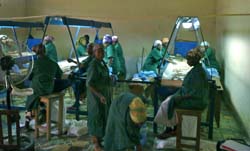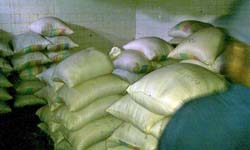On Sunday December 9th I returned from my visit to N2Africa Mozambique, the last leg of a trip that took me to all of the eight countries where the N2Africa project is implemented (excluding those countries that are serviced by the supplementary grant). Western Kenya, Nigeria, Ghana, Rwanda, Democratic Republic of Congo, Malawi, Zimbabwe and Mozambique were visited. These visits allowed me to meet and get to know project staff. Every opportunity to meet with partners was embraced and people have been very accommodating in making these meetings possible, meeting on Saturday or Sunday when needed and willing to travel distances when required. This is very much appreciated and I would like to thank everybody who contributed to making this a very successful trip.
We have visited the field on numerous occasions to interact with our implementing partners and with farmers, who are the ultimate beneficiaries of this project, and to get an impression of what is happening on the ground. I am much impressed by the welcome we received on all occasions, whether from a lead farmer who proudly gives an account of the legume crops she planted and how she manages the crop as well as how she demonstrated the technologies to other farmers, or farmer groups and associations who demonstrated the different recipes and presented the various food stuffs they prepared. We had very tasty meals which were, as you can imagine in sub-Sahara Africa, accompanied by a lot of dancing and singing. I also appreciated the exchange with our partners that allowed us to review our collaboration and discuss what is going well, where we can improve and, maybe most important of all, what we should do differently in the last phase of the project. My impression is that the N2Africa project is very well embedded in local structures. The project has played a role as an initiator, catalyst or stimulator of all these developments on the inputs systems, the smallholder production as well as the processing and marketing side, all along the soyabean and other legume crop value chains. I think we have realized a lot in the three years of the project, but the question for the last year of the project is how we can improve the sustainability of our interventions. The question of sustainability is one of how we can embed the technologies that we promote in the programs of our partners and putting the delivery and dissemination mechanisms in place that allow for further upscaling and outscaling of the technologies. We have convinced farmers and partners of the benefits of the improved varieties, use of inoculants and fertilizers, but this can only be sustained if the input distribution systems are in place that provide the farmers access to these inputs. That is something that we will focus on more in the last phase of the project. In similar manner the marketing and sale (linking farmers to markets) of the grains (and seed) is an important aspect and prerequisite for the sustained expansion of the number of farmers and area under legume crop cultivation. There are a number of opportunities (developments and high demand in the countries that can be built). So that will be another aspect that we will focus on this year. In most countries we have entered the last season in the project that will allow us to experiment with different D&D approaches and that will give us insight in how we can sustain the momentum that has been generated in the various countries towards putting nitrogen fixation to work for the smallholder farmers.
 |
Top: The women from IKURU ltd. (a partner in the N2Africa project Mozambique) sorting the groundnuts to get first grade groundnuts for export to the Netherlands. |
|
 |
Bottom: One of the stores of IITA Mozambique (Gurué) with different varieties of soyabean seeds waiting to be distributed to the various partners for dissemination to farmers |
|
| Right: A farmer proudly showing the beans he harvested from only 0.8 kg of seed (in the bucket) and the safe box that the savings and internal loans committee (SILC) keeps, with savings made partially from the proceeds of selling grain. The SILC is an element of the SMART project of CRS, one of our partners in Malawi |
 |
For the various trips I was accompanied by Alastair Simmons who has until recently, been the interim Project coordinator for the N2Africa and who now returns to his responsibility as our Communications, Knowledge and Project management officer. On quite a number of these country visits Matt Pycroft and Matt Sharman accompanied us as well. They are doing the video coverage. They have captured well what N2Africa is doing on the ground in addition to the opinions and visions of many of our partners and we will be able to tell the story of N2Africa in a varied way exploring different story lines.
Jeroen Huising
